Today, we will discover a collection of dazzling birds that all share one thing in common: their names start with the letter “L”! These remarkable avian creatures showcase a breathtaking array of colors, patterns, and unique features that will captivate your imagination.
So, without further ado, let’s find out the names of the most dazzling birds that start with “L”!
Lazuli Bunting (Passerina amoena)
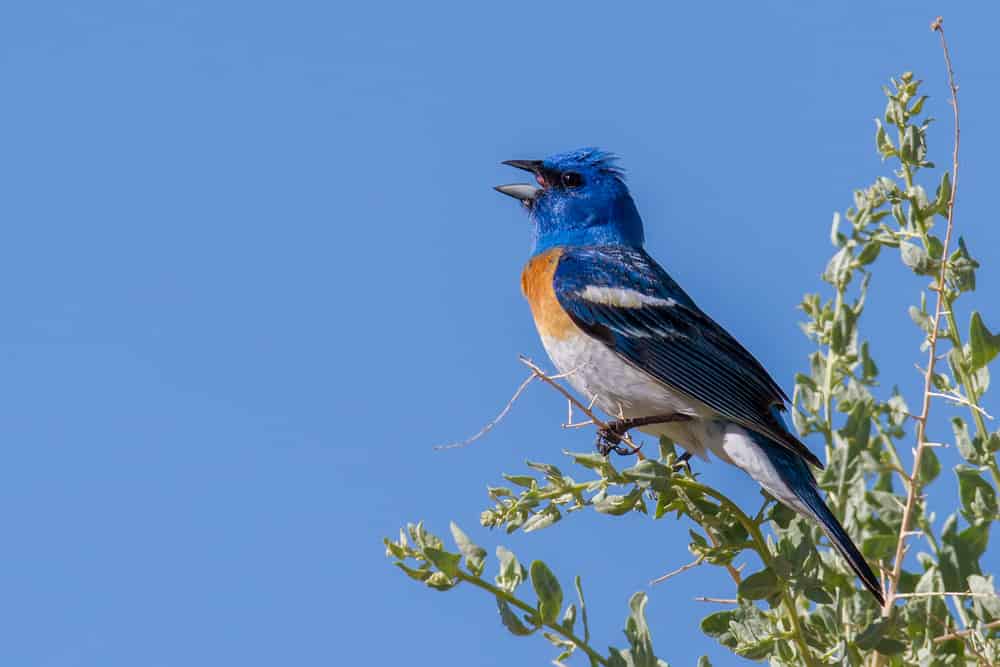
Blue songbirds that resemble finches, lazuli buntings live in North America.
©Ernest A Ross/Shutterstock.com
Lazuli buntings are colorful little songbirds that resemble finches. They have a sturdy build, with cone-shaped bills and foreheads that slope gently. These North American birds derive their name from the gemstone lapis lazuli.
The male lazuli bunting is especially striking, boasting a vivid blue head and back adorned with white wingbars and a lightly colored rusty breast. They make a long journey from their permanent residences in Canada and the US to southeastern Arizona and Mexico for their migratory season.
Little Blue Heron (Egretta caerulea)
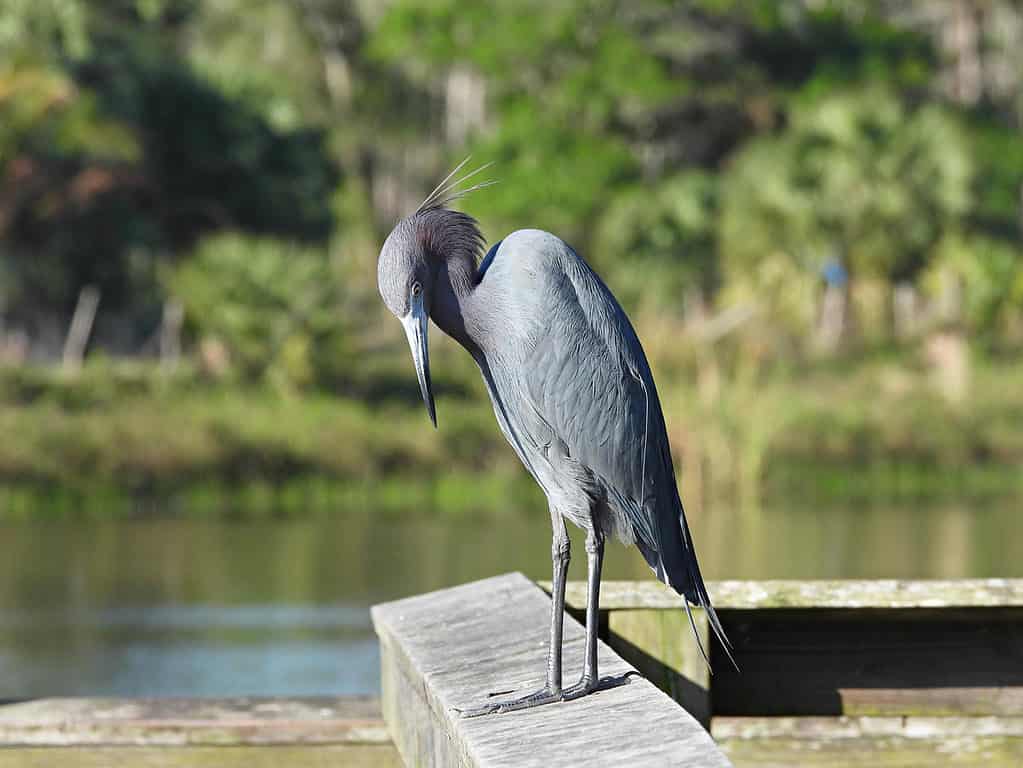
With a grayish-blue body, little blue herons live in the southern states of America.
©iStock.com/passion4nature
Little blue herons exhibit a captivating appearance, with a grayish-blue body and a striking dark red head during the breeding season. However, during non-breeding periods, their head and neck take on a beautiful purplish hue. These birds can be mostly spotted in southern states of the United States.
Surprisingly, the record for the oldest little blue heron known to date is 13 years and 11 months.
Least Sandpiper (Calidris minutilla)

The smallest shorebird in the States is the least sandpiper.
©Carrie Olson/Shutterstock.com
The least sandpiper holds the distinction of being the smallest shorebird in the US. It possesses a slender, black bill with a gentle downward curve at the tip. They also have short necks, long, yellowish legs, and reddish brown backs and wings adorned with black markings edged in white.
When foraging for food on the ground, these birds often walk with their heads lowered, searching for nourishment.
Little Egret (Egretta garzetta)

Another bird that starts with L is the little egret, a white bird found in England.
©Paul Wranek – Copyright A-Z Animals
A small white heron, the little egret, has attractive white plumes on its back, crest, and chest. It is characterized by its black legs, bill, and yellow feet. This bird is generally found along the east and south coasts of England.
In the past, the plumes of the little egret were highly sought after for adorning hats, leading to a craze in the 19th century when they became more valuable than gold.
Lesser Scaup (Aythya affinis)

Medium-sized ducks, lesser scaups have striking yellow eyes.
©Ray Hennessy/Shutterstock.com
The lesser scaup is a medium-sized diving duck with a distinctive peaked crown and a blue bill. Male lesser scaups, known as drakes, have dark purple heads, white sides, and striking yellow eyes. These ducks can be found throughout North America.
When it comes to migration, lesser scaups have a tendency to lag behind other waterfowl, making them unique in their timing.
Laughing Gull (Leucophaeus atricilla)

Found on the Atlantic coast of North America, laughing gulls have a striking black hood.
©Greens and Blues/Shutterstock.com
The laughing gull is a medium-sized bird with a gray upper body and a white underbody. During the summer, adults have a striking black hood, complemented by white arcs around the eye and a reddish bill. In winter, the hood transforms into a blurred gray mask atop a white head. Furthermore, the gull’s legs range from reddish-black to black in color.
These gulls form large colonies for breeding, generally found along the Atlantic coast of North America.
Laysan Albatross (Phoebastria immutabilis)
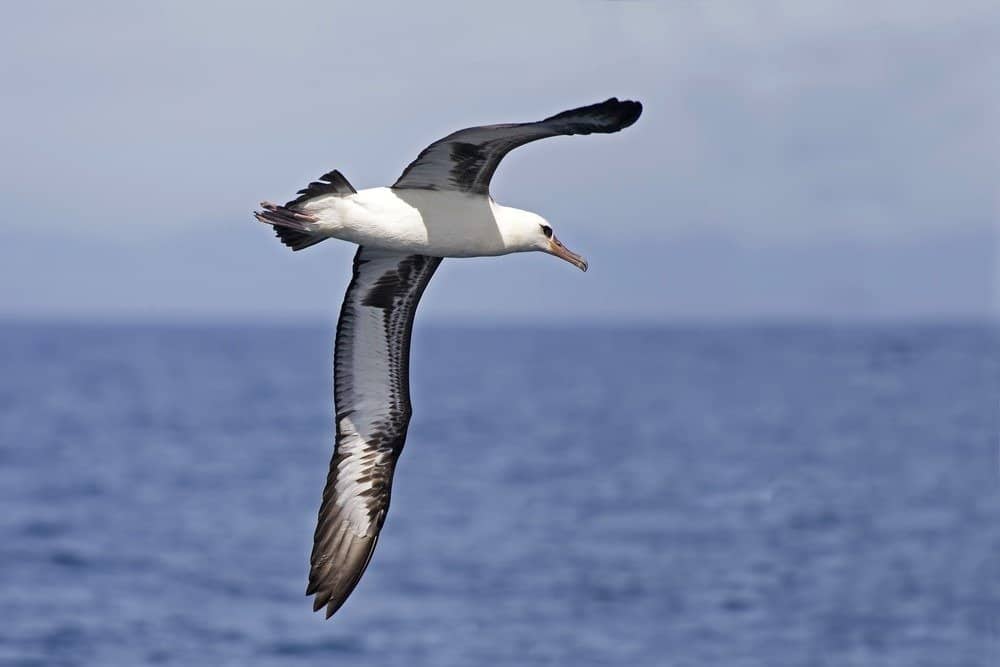
Similarly to other albatrosses, the Laysan albatross has a long lifespan.
©Harold Stiver/Shutterstock.com
The Laysan albatross is a bird with a white head, dark gray-brown upper wings, and predominantly white underwings that may have varying dark markings. Its underparts are pure white in color, while a dark patch surrounds its eye. These albatrosses establish their nests on open islands covered in sand or grass, primarily within the Hawaiian Islands chain.
Like other albatross species, the Laysan albatross is renowned for its long lifespan.
Loggerhead Shrike (Lanius ludovicianus)
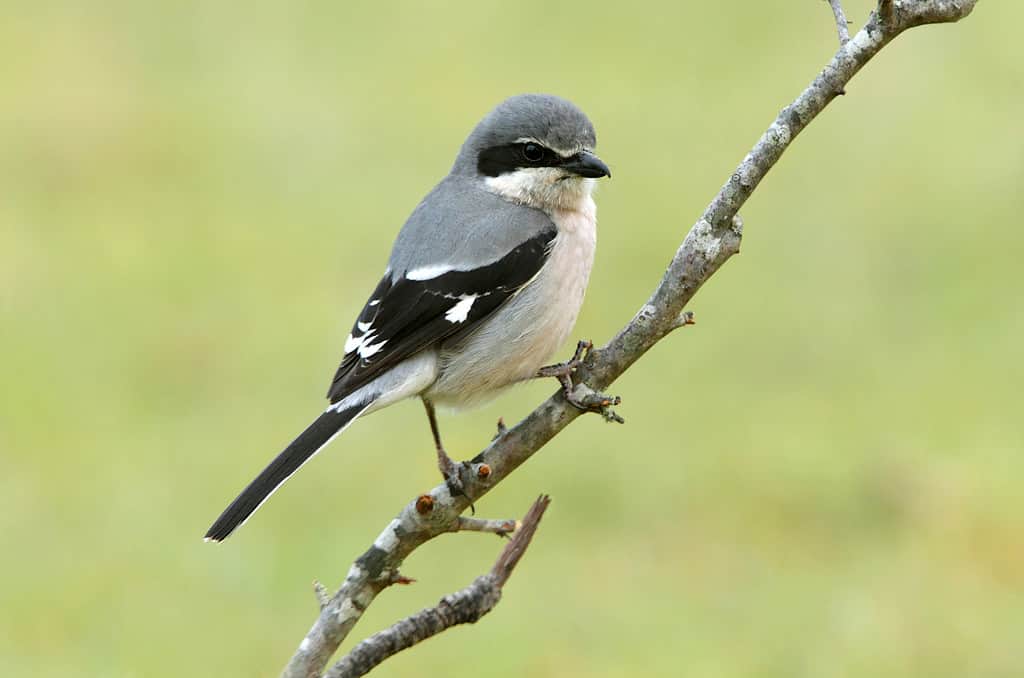
Blue-gray in color, the loggerhead shrike has a distinctive black mask.
©Cavan-Images/Shutterstock.com
The loggerhead shrike showcases a blue-gray head and back, while its breasts and bellies have faint white barring. Furthermore, their rumps range from gray to white in color. A distinctive feature of this bird is a wide black mask that extends across the eyes and slightly above, reaching toward the bill.
Remarkably, this shrike species is the only member of its family native to North America.
Lesser Goldfinch (Spinus psaltria)
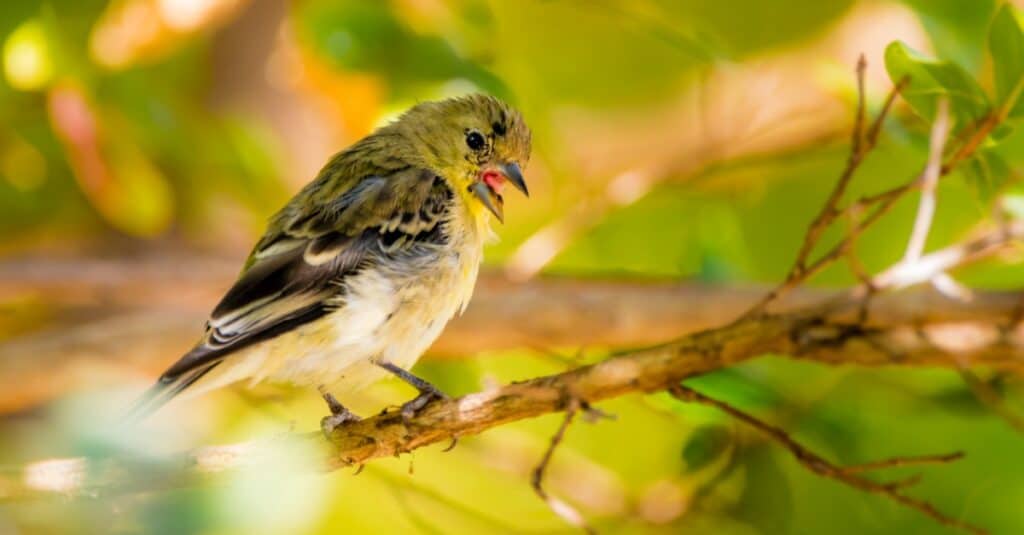
Lesser goldfinches can be found in California and Texas.
©iStock.com/Sunil Singh
With a black tail featuring prominent white corners, the lesser goldfinch possesses a distinct visual appeal. Female and immature lesser goldfinches have olive backs, dull yellow underparts, and black wings adorned with two whitish wing bars. These stunning birds are often seen gathering in flocks of several hundred individuals.
The lesser goldfinch is particularly abundant in California and Texas, and it is the smallest among all North American goldfinches.
Lawrence’s Goldfinch (Spinus lawrencei)

A North American songbird, Lawrence’s goldfinches are yellow in color.
©Linda Tanner from Los Osos, California, U.S.A. / CC BY 2.0 – Original / License
Male Lawrence’s goldfinches are renowned for their appearance among North American songbirds. They are a soft gray in color that is accentuated by a black face and abundant lemon-yellow plumage.
These striking birds are endemic to northern Baja California and arid woodlands in the foothills of California, making them a unique and cherished breeding species in their habitat.
Little Bittern (Ixobrychus minutus)
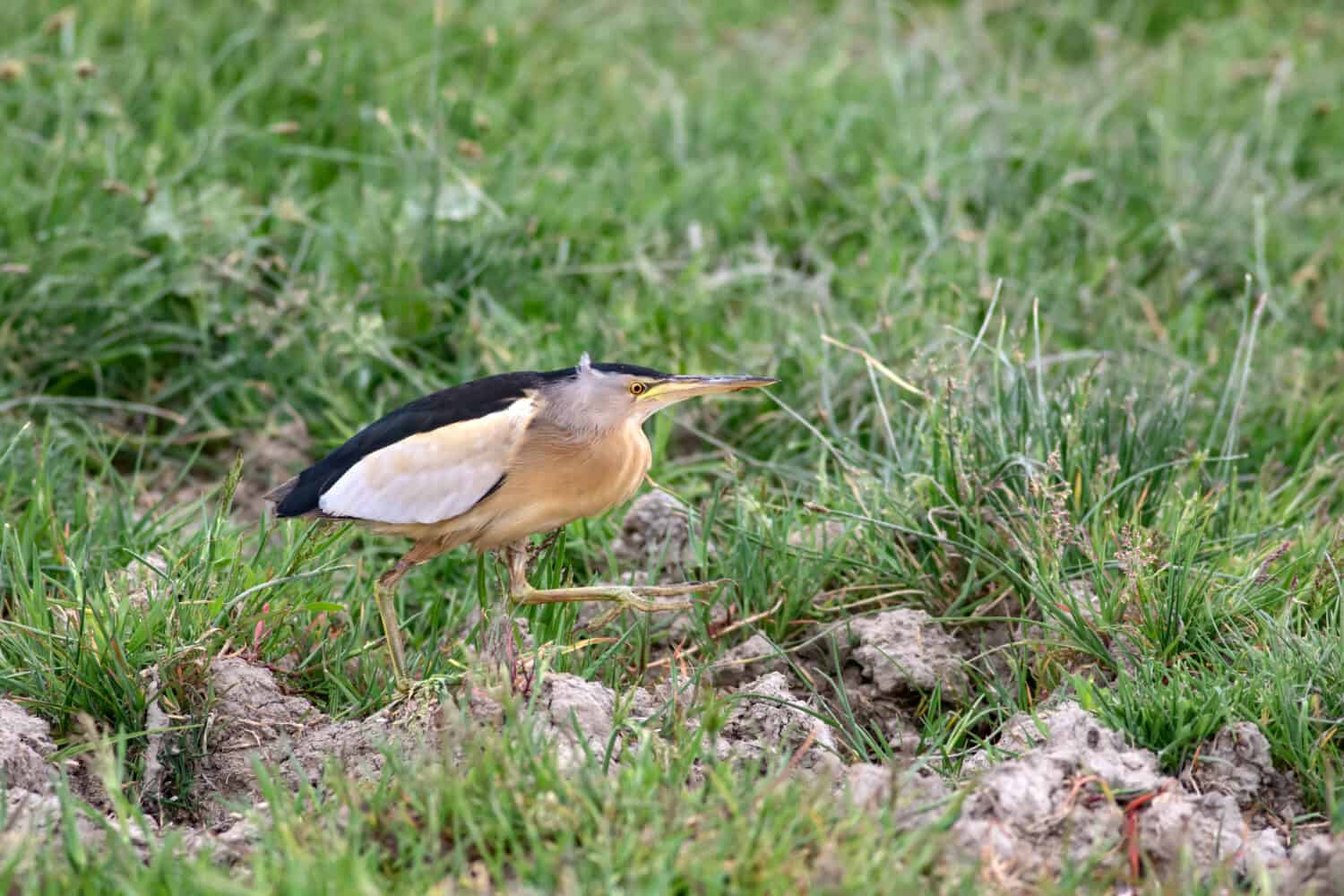
These birds almost look hunched over as the least bitterns keep their long necks drawn in.
©Greens and Blues/Shutterstock.com
Least bitterns are petite herons characterized by their long legs, toes, and dagger-like bills. They also possess long necks that they typically keep drawn in, creating a hunched posture.
While temperate region birds from Europe and western Asia undertake migration and winter in Africa and parts of Asia, those nesting in tropical regions tend to be sedentary, remaining in their breeding grounds year-round.
Lemon-Bellied Flycatcher (Microeca flavigaster)
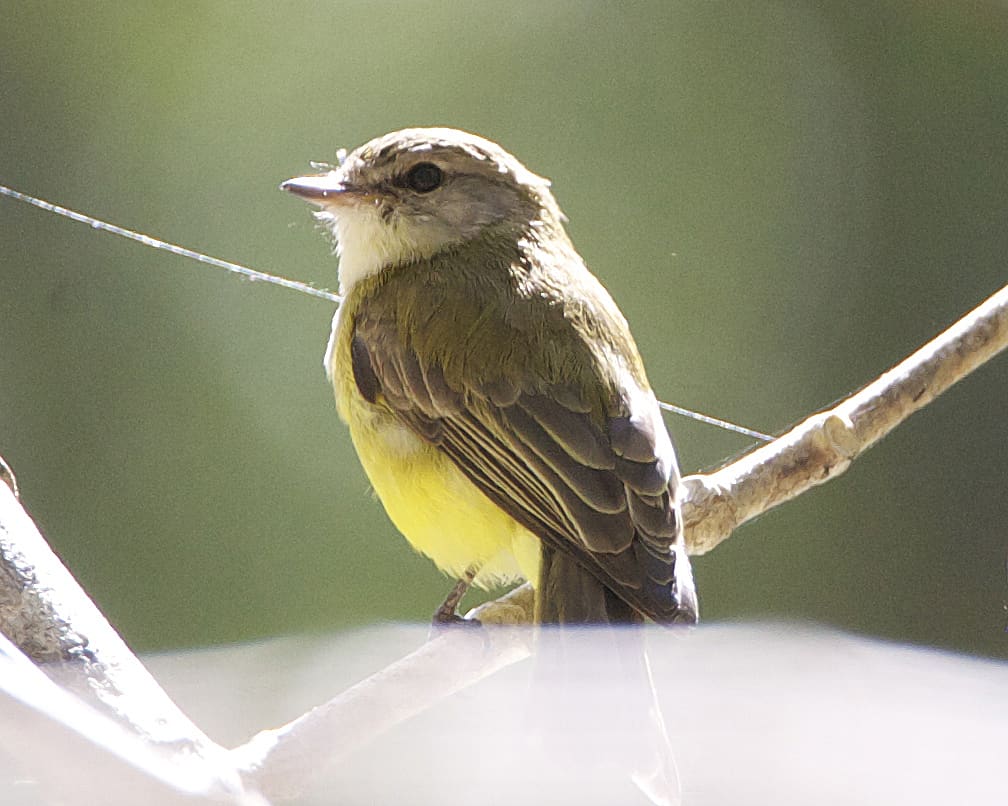
Lemon-bellied flycatchers are found in Australia, Indonesia, and Papua New Guinea.
©Lip Kee from Singapore, Republic of Singapore / CC BY-SA 2.0 – Original / License
The small Australian robin showcases a gray coloration on its upper body and lacks pale panels in its folded wings. Its tail lacks white markings as well. However, in the Kimberley subspecies, the pale belly displays a delightful wash of lemon yellow. These birds can only be found in Australia, Indonesia, and Papua New Guinea. Surprisingly, lemon-bellied flycatchers are among the few Australian passerines known to lay just one egg.
Lesser Flamingo (Phoeniconaias minor)
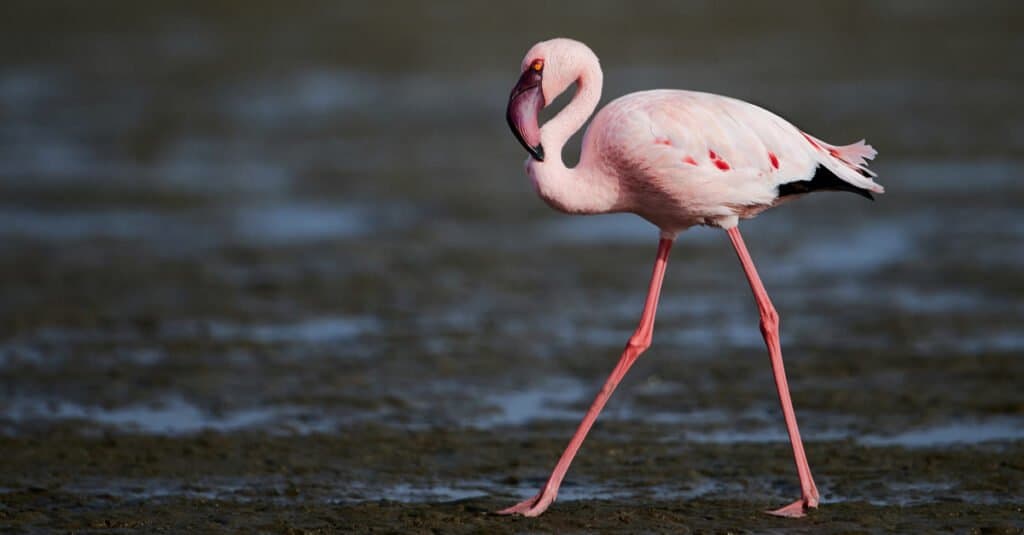
Interestingly, the lesser flamingo is the smallest flamingo species.
©mikex4/Shutterstock.com
The lesser flamingo is known for its tall stature, large body, long neck, and small head. These flamingos have pale pink plumage, legs, and bills. Comparatively to other flamingos, the lesser flamingo stands out as one of the smallest and most vibrant in color.
Breeding predominantly occurs in the saltwater lakes of the Rift Valley in East Africa. Surprisingly, flamingos possess a limited sense of taste and no sense of smell.
Least Grebe (Tachybaptus dominicus)

Tiny in size, the least grebe is metallic gray in color.
The least grebe is a unique waterbird, sporting a small size and a distinctive metallic gray plumage. Its notable golden eye adds a touch of brilliance, complemented by a tuft of white feathers at the rear. These birds have a vast range, spanning from the southwestern United States and South America.
Well-adapted to aquatic life, least grebes occasionally conceal themselves with only their bill visible, reminiscent of a miniature alligator.
Long-Eared Owl (Asio otus)

Like all owls, long-eared owls can fly silently.
©Feng Yu/Shutterstock.com
Long-eared owls exhibit a dusky appearance with buff or orange faces adorned with intricate black, brown, and buff feather patterns. The black ear tufts feature fringes of buff or orange, while the face displays two vertical white lines between the eyes. Their yellow eyes also add to their distinctive features. Like their owl counterparts, long-eared owls possess adaptations for silent flight and precise hunting.
While extensively studied in the United States and Europe, limited information is available regarding this owl’s biology in other regions of its range.
Lava Gull (Leucophaeus fuliginosus)

The rarest gull in the world is the lava gull.
©DickDaniels (http://theworldbirds.org/) / CC BY-SA 3.0 – Original / License
The lava gull, also known as the Galapagos lava gull, has a black head, wings, and a dark grey body. Its belly is a paler shade of grey. The bill and legs are black, while the inside of the mouth is a striking scarlet. This gull is the world’s rarest, with a population of only 300-600 individuals.
The lava gull is exclusively found in the Galapagos Islands, adding to its charm and conservation significance.
Large Hawk-Cuckoo (Hierococcyx sparverioides)
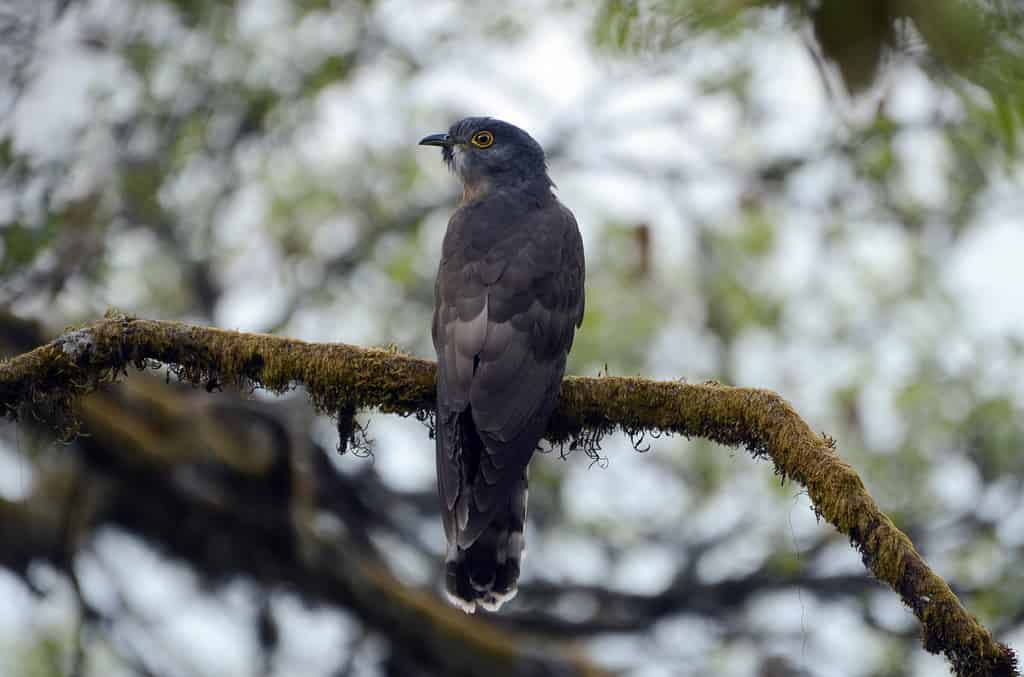
As evidenced by its name, the large hawk-cuckoo looks like a hawk.
The large hawk-cuckoo exhibits a hawk-like appearance, with brown upperparts, patterned white underparts, and a long barred tail. Adult individuals also have an orangish flush on their chest.
With a wide breeding range spanning from temperate Asia along the Himalayas to East Asia, this species has diverse populations that migrate to more southern regions during winter. Notably, they are recognized for their distinctive and repetitive loud calls.
Laysan Duck (Anas laysanensis)
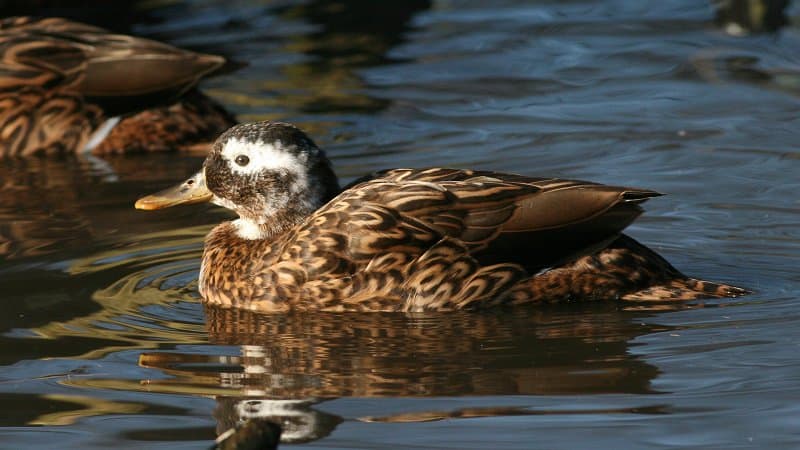
Native to Hawaii, the Layson duck has blotched coloration.
The Laysan duck, roughly the size of a teal, showcases a dark brown plumage accentuated by a white eye ring. Males possess a short, spatulate, dark green bill with varying black blotching, while females have a dull orange bill with similar blotching. These ducks also generally have a ring of fat around their necks.
Endemic to Hawaii, they were previously confined to Laysan Island. However, due to its extremely small range and significant population fluctuations, this species is now listed as critically endangered.
Laughing Falcon (Herpetotheres cachinnans)
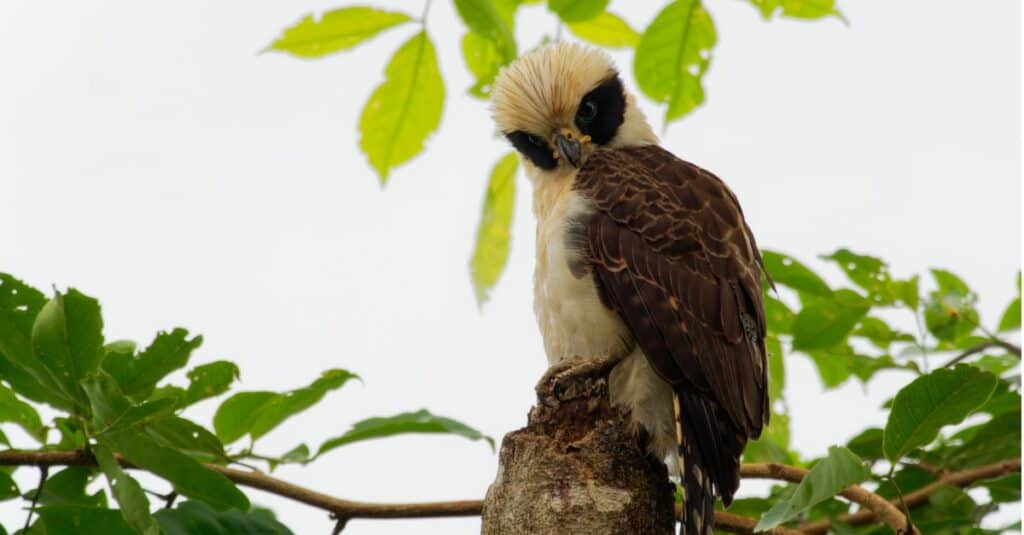
A beautiful bird, the laughing flacon has a dark mask across its face.
©iStock.com/phototrip
The laughing falcon stands out with its notable dark mask that extends the side of its face and across its eyes. This striking feature beautifully contrasts with its creamy white chest and head. It also boasts a distinct black and white banded tail, dark eyes and legs, and a yellow cere.
Native to Mexico, Central, and South America, this raptor is renowned for being one of the most easily noticeable birds of prey in the Neotropical region.
Lilian’s Lovebird (Agapornis lilianae)
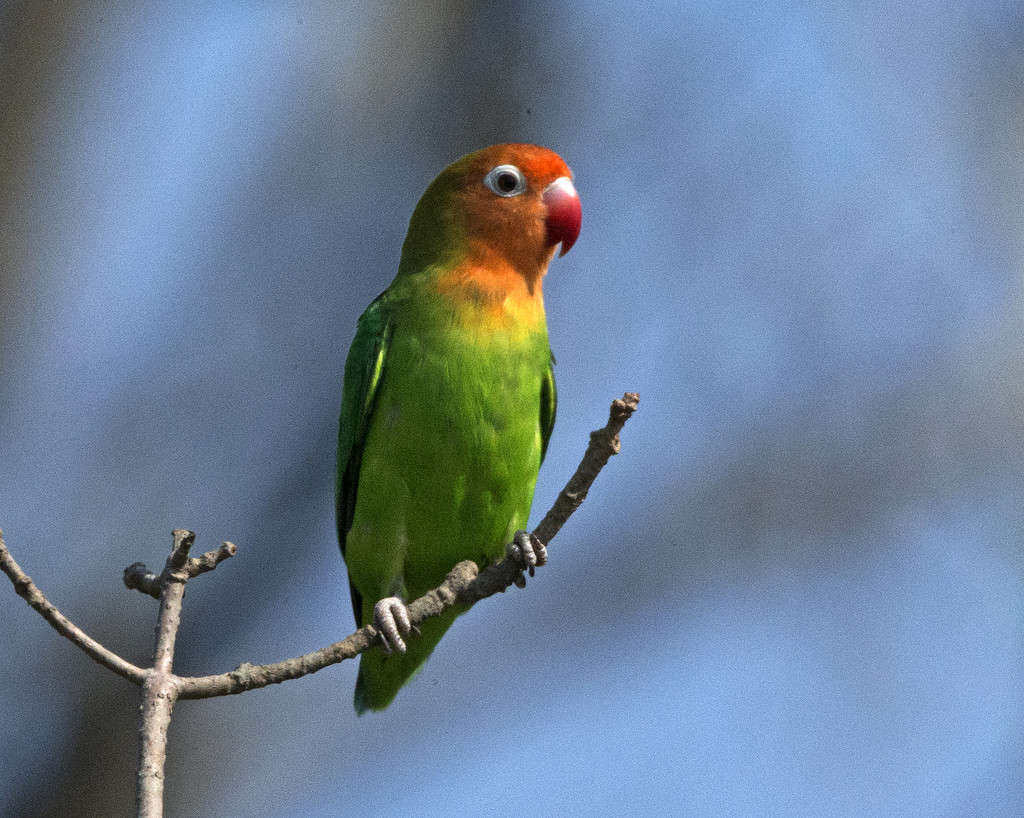
Mostly green in color, the Lilian’s lovebird is also known as the Nyasa lovebird.
©Lip Kee from Singapore, Republic of Singapore / CC BY-SA 2.0 – Original / License
The Lilian’s lovebird is predominantly green, with white eyerings. It displays vibrant orange hues on its head, neck, and upper chest while boasting a green rump. Interestingly, male and female birds share an identical external appearance.
Also known as the Nyasa lovebird, it belongs to the small parrot species within the lovebird genus. This bird can be found in select African countries. Notably sociable, Lilian’s lovebird forms groups consisting of approximately 20 individuals.
Long-Tailed Manakin (Chiroxiphia linearis)
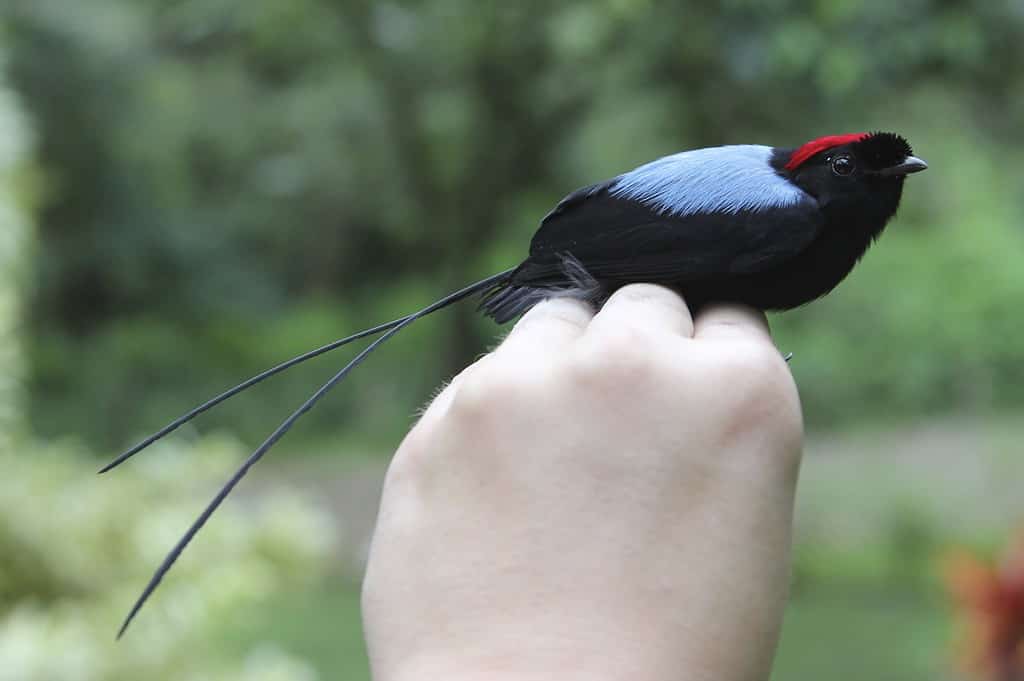
The beautiful colors of the long-tailed manakin give it a striking appearance.
The long-tailed manakin male is a rich black in color, complemented by a vibrant red crown and legs. Its bright blue back adds to its striking appearance, while the elongated central tail feathers create an eye-catching feature. In contrast, the female exhibits an olive green hue, with paler tones on the lower body and chin. Some females may also possess a small amount of red in their crowns.
Native to Central America, these birds thrive in both wet and dry tropical and subtropical forests.
Little Spiderhunter (Arachnothera longirostra)

The most distinctive feature of the little spiderhunter is its long and curved black beak.
The little spiderhunter is recognized by its long and downward-curved black beak. Its upper plumage showcases an olive-green shade, while the lower body is vibrant yellow with striking black streaks. With large, dark eyes, these birds are typically found in the moist forests of South and Southeast Asia.
When disturbed or foraging, they emit a buzzy zick-zick call, while their song consists of a series of rapid chipping notes that can persist for extended periods.
Little Pied Cormorant (Microcarbo melanoleucos)
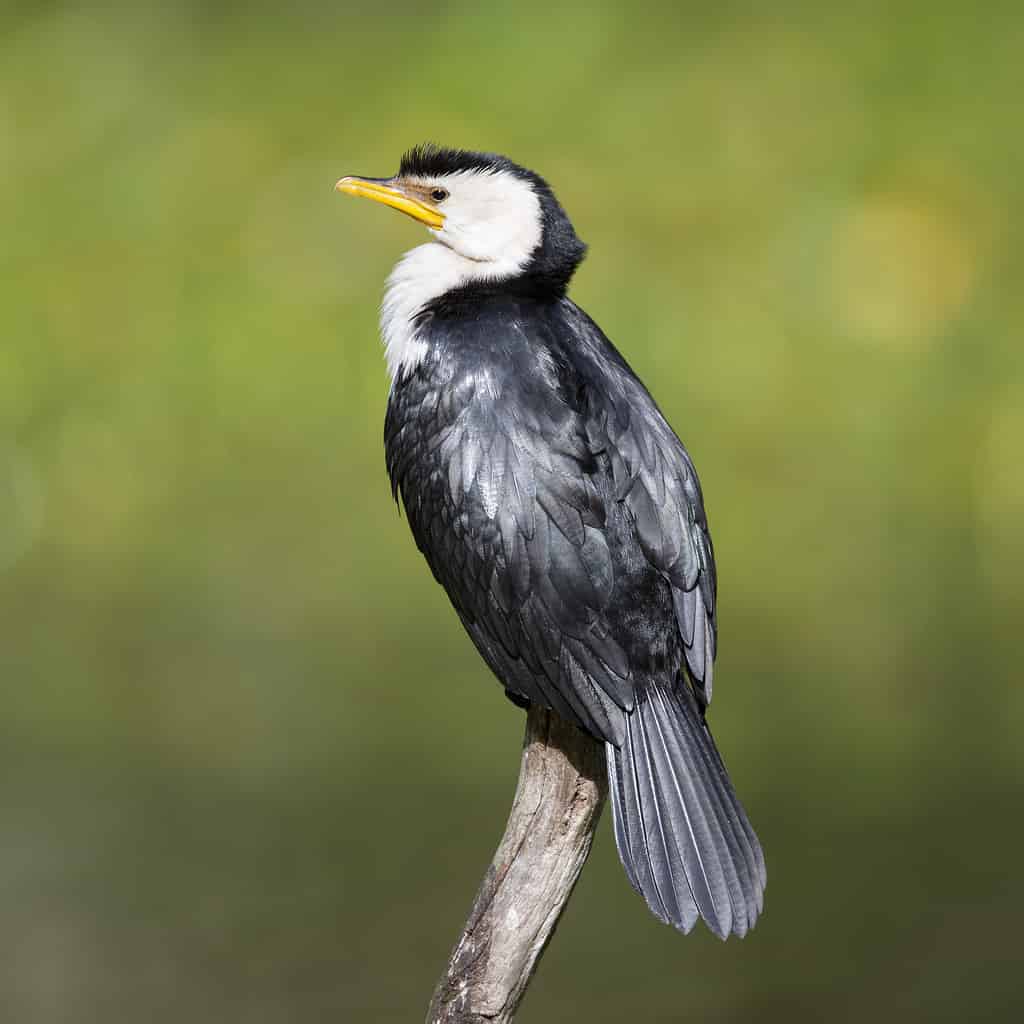
Found in Australia, the little pied cormorant is black and white in color.
©JJ Harrison (https://tiny.jjharrison.com.au/t/FnUZGFQR6SInLXmd) / CC BY-SA 4.0 – Original / License
Another bird that starts with L is the little pied cormorant. The little pied cormorant has a black upper body and white or rusty-colored underparts. Adult individuals have white plumage extending above their eyes, along with a yellow bill. These cormorants can be found across the entirety of Australia.
These birds are colonial, often forming large flocks near islands and inland saltwater lakes. In these communal settings, they engage in activities such as roosting, breeding, and hunting.
The Largest Bird That Starts with L

The lappet-faced vulture is the largest bird that starts with the letter L.
©Martin Pelanek/Shutterstock.com
The largest bird that starts with L is none other than the lappet-faced vulture. This giant bird is known for its remarkable size and possesses a robust head and a strong bill. Its predominantly dark feathers create a striking contrast with its captivating bare pink head and the noticeable flaps of flesh on the sides of its neck.
As the largest vulture in Africa, this creature roams across extensive regions in Africa and the Middle East. It thrives in dry and semi-arid landscapes adorned with sparse trees, thorny bushes, and short grass.
When it comes to measurements, the lappet-faced vulture typically reaches a body length of about 37 to 45 inches, accompanied by an impressive wingspan ranging from 8.2 to 9.5 feet. These birds can weigh up to an astonishing 30 pounds.
Although primarily a scavenger, this magnificent vulture has versatile hunting skills, targeting a diverse range of prey such as reptiles, small mammals, and even birds.
The Fastest Bird That Starts with L
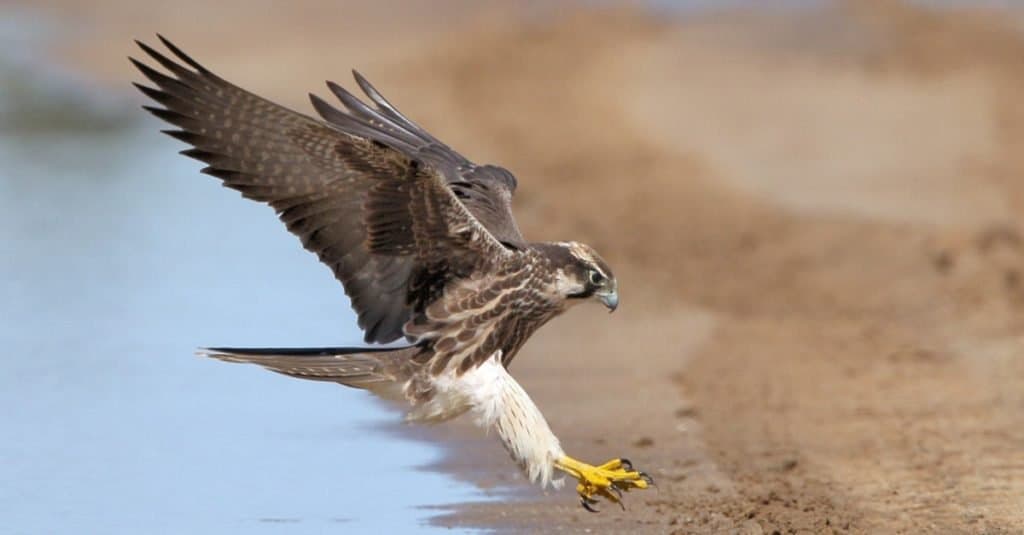
The fastest bird that starts with the letter L is the lanner falcon.
©Neal Cooper/Shutterstock.com
The lanner falcon is the fastest bird beginning with L. It has an incredible speed of almost 90 mph, making it one of the swiftest avian species worldwide!
This medium-sized yet powerful bird of prey boasts impressive capabilities. European lanner falcons exhibit slate grey or brown-grey upper parts, while most African subspecies showcase a lighter blue-grey hue. Northern variants display a streaked breast and a reddish back of the head.
With a length ranging from 17 to 20 inches and a wingspan spanning 37 to 41 inches, this falcon impresses with its size. Surprisingly, it weighs a mere 1.1 to 2 pounds!
The lanner falcon can be found across extensive regions in the Mediterranean, the Middle East, and certain parts of Africa. Its preferred prey consists of small to medium-sized birds like thrushes or pigeons. However, it also feeds on small mammals, insects, bats, and reptiles. Although rare, there have been instances where the lanner falcon has been observed hunting domestic fowl.
Summary of Amazing Birds That Start with L
| Common Name | Scientific Name |
|---|---|
| Lazuli Bunting | Passerina amoena |
| Little Blue Heron | Egretta caerulea |
| Least Sandpiper | Calidris minutilla |
| Little Egret | Egretta garzetta |
| Lesser Scaup | Aythya affinis |
| Laughing Gull | Leucophaeus atricilla |
| Laysan Albatross | Phoebastria immutabilis |
| Loggerhead Shrike | Lanius ludovicianus |
| Lesser Goldfinch | Spinus psaltria |
| Lawrence’s Goldfinch | Spinus lawrencei |
| Little Bittern | Ixobrychus minutus |
| Lemon-breasted Flycatcher | Microeca flavigaster |
| Lesser Flamingo | Phoeniconaias minor |
| Least Grebe | Tachybaptus dominicus |
| Long-eared Owl | Asio otus |
| Laval Gull | Leucophaeus fuliginosus |
| Large Hawk-cuckoo | Hierococcyx sparverioides |
| Laysan Duck | Anas laysanensis |
| Laughing Falcon | Herpetotheres cachinnans |
| Lillian’s Lovebird | Agapornis lilianae |
| Long-tailed Manakin | Chiroxiphia linearis |
| Little Spiderhunter | Arachnothera longirostra |
| Little Pied Cormorant | Microcarbo melanoleucos |
| Lappet-Faced Vulture | Torgos tracheliotos |
| Lanner Falcon | Falco biarmicus |
The photo featured at the top of this post is © Jackfrowde / CC BY-SA 4.0 – License / Original
Thank you for reading! Have some feedback for us? Contact the AZ Animals editorial team.







